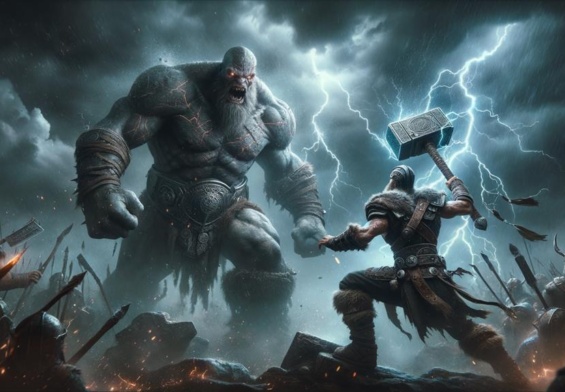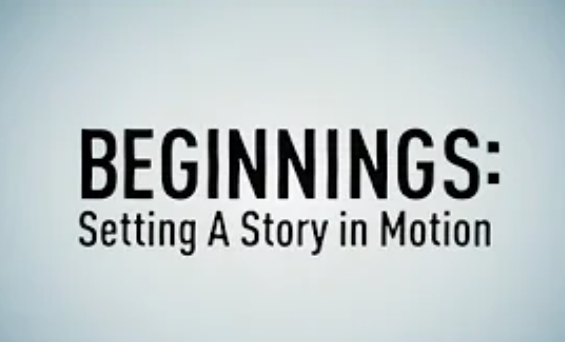By Daniel McCoy
Ragnarok is the cataclysmic destruction of the cosmos and everything in it – even the gods. When Norse mythology is considered as a chronological set of tales, the story of Ragnarok naturally comes at the very end. For the Vikings, the myth of Ragnarok was a prophecy of what was to come at some unspecified and unknown time in the future, but it had profound ramifications for how the Vikings understood the world in their own time. We’ll explore some of those ramifications below.
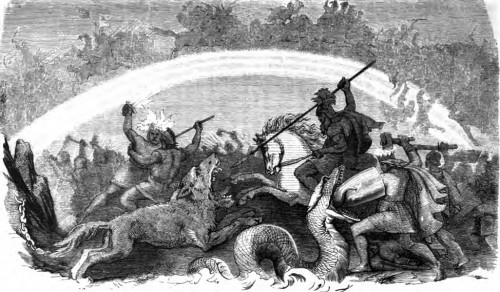
The word “Ragnarok” comes from Old Norse Ragnarök, “Fate of the Gods.” In an apparent play on words, some pieces of Old Norse literature also refer to it as Ragnarøkkr, “Twilight of the Gods.” The event was also occasionally referred to as aldar rök, “fate of mankind,” and a host of other names.
Without further ado, here’s the tale itself:
The Fate of the Gods
Someday – whenever the Norns, those inscrutable spinners of fate, decree it – there shall come a Great Winter (Old Norse fimbulvetr, sometimes Anglicized as “Fimbulwinter”) unlike any other the world has yet seen. The biting winds will blow snows from all directions, and the warmth of the sun will fail, plunging the earth into unprecedented cold. This winter shall last for the length of three normal winters, with no summers in between. Mankind will become so desperate for food and other necessities of life that all laws and morals will fall away, leaving only the bare struggle for survival. It will be an age of swords and axes; brother will slay brother, father will slay son, and son will slay father.

The wolves Skoll and Hati, who have hunted the sun and the moon through the skies since the beginning of time, will at last catch their prey. The stars, too, will disappear, leaving nothing but a black void in the heavens. Yggdrasil, the great tree that holds the cosmos together, will tremble, and all the trees and even the mountains will fall to the ground. The chain that has been holding back the monstrous wolf Fenrir will snap, and the beast will run free. Jormungand, the mighty serpent who dwells at the bottom of the ocean and encircles the land, will rise from the depths, spilling the seas over all the earth as he makes landfall.
These convulsions will shake the ship Naglfar (“Nail Ship”) free from its moorings. This ship, which is made from the fingernails and toenails of dead men and women, will sail easily over the flooded earth. Its crew will be an army of giants, the forces of chaos and destruction. And its captain will be none other than Loki, the traitor to the gods, who will have broken free of the chains in which the gods have bound him.
Fenrir, with fire blazing from his eyes and nostrils, will run across the earth, with his lower jaw on the ground and his upper jaw against the top of the sky, devouring everything in his path. Jormungand will spit his venom over all the world, poisoning land, water, and air alike.
The dome of the sky will be split, and from the crack shall emerge the fire-giants from Muspelheim. Their leader shall be Surt, with a flaming sword brighter than the sun in his hand. As they march across Bifrost, the rainbow bridge to Asgard, the home of the gods, the bridge will break and fall behind them. An ominous horn blast will ring out; this will be Heimdall, the divine sentry, blowing the Gjallarhorn to announce the arrival of the moment the gods have feared. Odin will anxiously consult the head of Mimir, the wisest of all beings, for counsel.
The gods will decide to go to battle, even though they know what the prophecies have foretold concerning the outcome of this clash. They will arm themselves and meet their enemies on a battlefield called Vigrid (Old Norse Vígríðr, “Plain Where Battle Surges”).
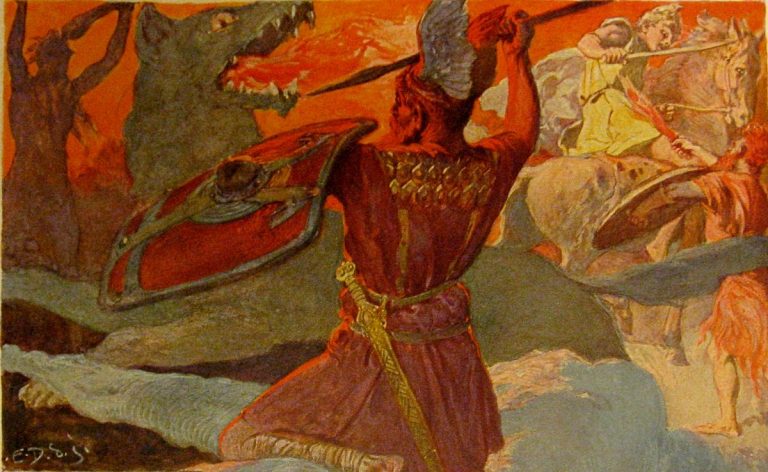
Odin will fight Fenrir, and by his side will be the einherjar, the host of his chosen human warriors whom he has kept in Valhalla for just this moment. Odin and the champions of men will fight more valiantly than anyone has ever fought before. But it will not be enough. Fenrir will swallow Odin and his men. Then one of Odin’s sons, Vidar, burning with rage, will charge the beast to avenge his father. On one of his feet will be the shoe that has been crafted for this very purpose; it has been made from all the scraps of leather that human shoemakers have ever discarded, and with it Vidar will hold open the monster’s mouth. Then he will stab his sword through the wolf’s throat, killing him.
Another wolf, Garm, and the god Tyr will slay each other. Heimdall and Loki will do the same, putting a final end to the trickster’s treachery, but costing the gods one of their best in the process. The god Freyr and the giant Surt will also be the end of each other. Thor and Jormungand, those age-old foes, will both finally have their chance to kill the other. Thor will succeed in felling the great snake with the blows of his hammer. But the serpent will have covered him in so much venom that he will not be able to stand for much longer; he will take nine paces before falling dead himself and adding his blood to the already-saturated soil of Vigrid.
Then the remains of the world will sink into the sea, and there will be nothing left but the void. Creation and all that has occurred since will be completely undone, as if it had never happened.
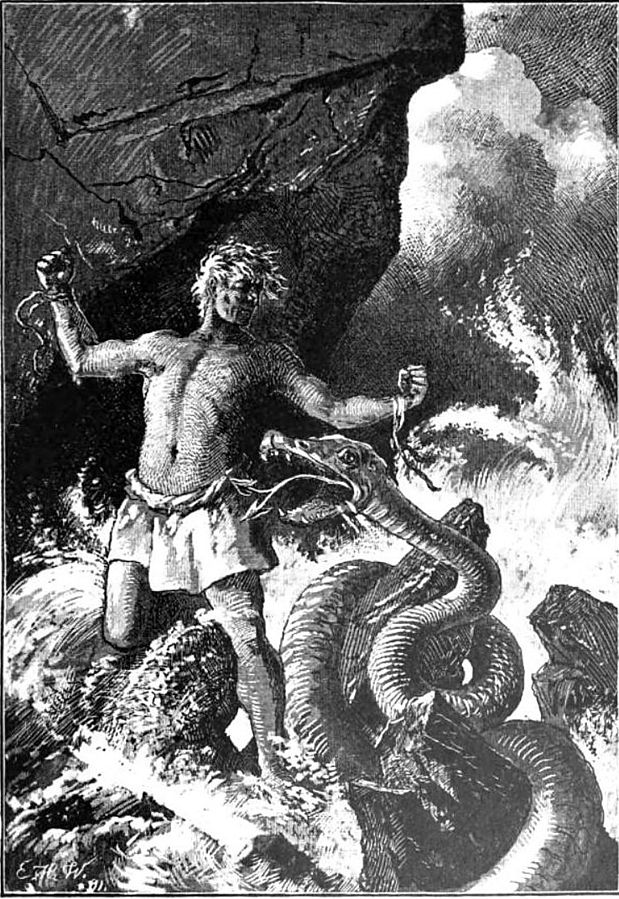
Some say that that is the end of the tale – and of all tales, for that matter. But others hold that a new world, green and beautiful, will arise out of the waters. Vidar and a few other gods – Vali, Baldur, Hodr, and Thor’s sons Modi and Magni – will survive the downfall of the old world, and will live joyously in the new one. A man and a woman, Lif and Lifthrasir (Old Norse Líf and Lífþrasir, “Life” and “Striving after Life”), will have hidden themselves from the cataclysm in a place called the “Wood of Hoddmimir” (Hoddmímis holt), and will now come out and populate the lush land in which they will find themselves. A new sun, the daughter of the previous one, will rise in the sky. And all of this will be presided over by a new, almighty ruler.
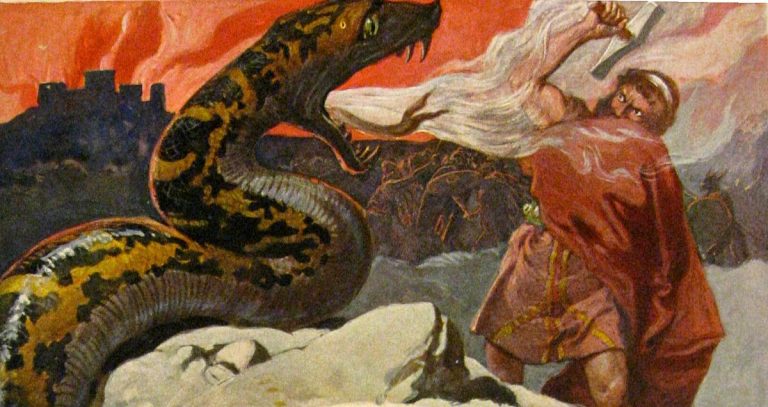
The Meaning of Ragnarok for the Vikings
Imagine that you’re a Viking. You live in a world that you know will one day be obliterated. The very gods themselves will perish with it. Nothing of value will be spared – not even the memory of anything that ever had value. How does such a world look to you in the present moment, given that the seeds of that final destruction have already been sown, and the world is careening inexorably toward that final decisive moment? Would this not cast a dark hue of tragedy, senselessness, and futility over the world and everything that occurs within it? Indeed, it’s hard to escape the conclusion that this was how the Vikings saw the world on one level.
Yet Ragnarok also carried another meaning for them, one which complemented yet altered this tragic view of life.
In addition to being a prophecy about the future that revealed much about the underlying nature of the world along the way, the myth of Ragnarok also served as a paradigmatic model for human action. For the Vikings, the tale didn’t produce hopelessness as much as inspiration and invigoration. Just as the gods will one day die, so too will each individual human being. And just as the gods will go out and face their fate with dignity, honor, and courage, so too can humans. In this view, the inevitability of death and misfortune should not paralyze us, but should instead spur us to hold noble attitudes and do noble deeds – the kind worthy of being recounted by bards many generations after we ourselves are gone.



